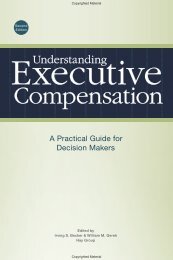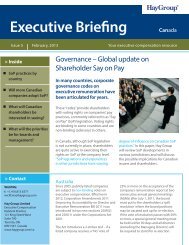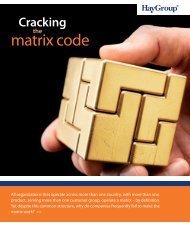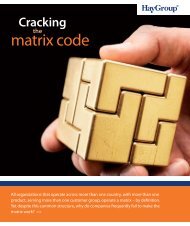Executive Benefits Survey Results of the 2011 ... - Hay Group
Executive Benefits Survey Results of the 2011 ... - Hay Group
Executive Benefits Survey Results of the 2011 ... - Hay Group
Create successful ePaper yourself
Turn your PDF publications into a flip-book with our unique Google optimized e-Paper software.
3 <strong>Executive</strong> <strong>Benefits</strong> <strong>Survey</strong><br />
Introduction<br />
In July and August <strong>2011</strong>, <strong>Hay</strong> <strong>Group</strong> conducted a survey <strong>of</strong> executive retirement benefits and<br />
perquisites. Our primary objective was to obtain current data on <strong>the</strong> prevalence <strong>of</strong> practice<br />
regarding executive retirement, deferred compensation and perquisites for employers <strong>of</strong> all<br />
sizes and across a broad group <strong>of</strong> industries. Since we last conducted a survey on executive<br />
benefits more than 5 years ago, <strong>the</strong> struggling national and global economies, declining<br />
share prices and expanded proxy disclosures have created an intense public focus on<br />
executive benefits. This environment is causing boards <strong>of</strong> both for pr<strong>of</strong>it and not for pr<strong>of</strong>it<br />
organizations to focus more on <strong>the</strong> level and composition <strong>of</strong> executive benefit programs.<br />
Boards also want to structure <strong>the</strong>ir programs in a market-competitive manner that serves<br />
shareholders’ and/or public interests.<br />
An electronic survey questionnaire was made available to employees in a position to provide<br />
information on <strong>the</strong>ir companies’ executive benefits policies. <strong>Hay</strong> <strong>Group</strong> tabulated and sorted<br />
<strong>the</strong> results from 317 responding employers with median revenue <strong>of</strong> nearly $1billion. 16% <strong>of</strong><br />
<strong>the</strong> respondents are tax exempt organizations.<br />
<strong>Executive</strong> Retirement Plans<br />
Nearly half <strong>of</strong> <strong>the</strong> participating organizations provide some type <strong>of</strong> nonqualified retirement<br />
plan, ei<strong>the</strong>r defined benefit or defined contribution (refer to <strong>the</strong> bottom <strong>of</strong> this page for<br />
definitions). The table below shows not only <strong>the</strong> overall prevalence, but also <strong>the</strong> eligibility by<br />
executive group.<br />
<strong>Executive</strong> Retirement Offered<br />
President &<br />
CEO<br />
<strong>Executive</strong><br />
and Senior<br />
VPs<br />
© <strong>2011</strong> <strong>Hay</strong> <strong>Group</strong>. All rights reserved. www.haygroup.com<br />
VPs<br />
Division<br />
Heads<br />
Based on<br />
Compensation<br />
Nonqualified Retirement Plan 49% 66% 57% 42% 17% 32%<br />
Defined Benefit 32% 74% 69% 49% 26% 35%<br />
Defined Contribution 31% 73% 72% 60% 37% 39%<br />
Of those organizations that provide this type <strong>of</strong> benefit, one third provide both a defined<br />
benefit and defined contribution plan, while <strong>the</strong> remaining two thirds provide only one type <strong>of</strong><br />
nonqualified retirement plan.<br />
The trend away from defined benefit plans continues, in both qualified and nonqualified<br />
arrangements. The data may suggest that organizations with both a DB and DC<br />
arrangements have grandfa<strong>the</strong>red executives into <strong>the</strong> DB program and <strong>of</strong>fer a DC program<br />
to new executives.<br />
Nonqualified<br />
Retirement<br />
Plan<br />
Nonqualified<br />
Defined<br />
Benefit Plan<br />
Nonqualified<br />
Defined<br />
Contribution<br />
Plan<br />
<strong>Executive</strong> Retirement Plan Definitions<br />
Supplemental executive retirement plans (SERP), such as top-hat plans or excess plans, which<br />
provide certain employees with additional retirement benefits. These plans may be free-standing<br />
plans that cover several executives or <strong>the</strong>y may be part <strong>of</strong> individual executive employment<br />
contracts.<br />
Retirement plan that provides a fixed benefit at retirement based on a formula or target income<br />
percentage. The plan is not qualified under <strong>the</strong> Internal Revenue Code (IRC) and is usually in<br />
addition to a qualified defined benefit plan. This type <strong>of</strong> plan is designed to supplement defined<br />
benefit pensions and/or restore benefits in pension plans that are limited by ERISA.<br />
Retirement plan in which employers make fixed contributions toward retirement. The plan is not<br />
qualified under <strong>the</strong> IRC and is typically in addition to qualified defined contribution plans (401(k),<br />
403(b), etc.) This type <strong>of</strong> plan is designed to supplement defined contribution plans and/or restore<br />
benefits that are limited by ERISA.

















